Welcome to DU!
The truly grassroots left-of-center political community where regular people, not algorithms, drive the discussions and set the standards.
Join the community:
Create a free account
Support DU (and get rid of ads!):
Become a Star Member
Latest Breaking News
General Discussion
The DU Lounge
All Forums
Issue Forums
Culture Forums
Alliance Forums
Region Forums
Support Forums
Help & Search
Celerity
Celerity's Journal
Celerity's Journal
July 28, 2022
https://thebanter.substack.com/p/merrick-garland-is-doing-his-job

WASHINGTON, DC – Last week, I wrote a piece titled “Here’s What We Know About Merrick Garland And Trump,” with the subheadline, “It’s not difficult to see how two-plus-two equals Trump’s in big trouble.” And now, a week later, it turns out I was exactly right with that forecast. On Tuesday, The Washington Post dropped a colossal bombshell onto the soft, mostly empty skulls of Donald Trump and his Red Hat minions:

As I mentioned last week, the grand jury – or grand juries, plural – have been criminally investigating Trump and his henchmen since at least February, when insider Peter Navarro was subpoenaed for records and testimony related to his former boss, Trump. The Washington Post added further confirmation that the grand jury preceded the 1/6 hearings::

snip
Merrick Garland Is Doing His Job, Now We Must Do Ours - By Winning
This is a historically unprecedented investigation, but without the public Garland doesn't have enough time to prosecute Donald Trump.https://thebanter.substack.com/p/merrick-garland-is-doing-his-job

WASHINGTON, DC – Last week, I wrote a piece titled “Here’s What We Know About Merrick Garland And Trump,” with the subheadline, “It’s not difficult to see how two-plus-two equals Trump’s in big trouble.” And now, a week later, it turns out I was exactly right with that forecast. On Tuesday, The Washington Post dropped a colossal bombshell onto the soft, mostly empty skulls of Donald Trump and his Red Hat minions:

As I mentioned last week, the grand jury – or grand juries, plural – have been criminally investigating Trump and his henchmen since at least February, when insider Peter Navarro was subpoenaed for records and testimony related to his former boss, Trump. The Washington Post added further confirmation that the grand jury preceded the 1/6 hearings::

snip
July 28, 2022



The Saudi Arabian government has unveiled visuals of a 500-metre-tall linear city named The Line, which will be built near the Red Sea as part of Neom. Set to stretch 170 kilometres across northwest Saudi Arabia, the megastructure, which will have mirrored facades, will be 500 metres tall, but only 200 meters wide. Planned as part of the Neom development, The Line was designed as a dramatic alternative to traditional cities that typically radiate out from a central point. Although it has not been officially announced, Dezeen understands that the megastructure was designed by US studio Morphosis.



"At The Line’s launch last year, we committed to a civilizational revolution that puts humans first based on a radical change in urban planning," said Saudi Arabia's crown prince Mohammed bin Salman. "The designs revealed today for the city's vertically layered communities will challenge the traditional flat, horizontal cities and create a model for nature preservation and enhanced human liveability," he continued. "The Line will tackle the challenges facing humanity in urban life today and will shine a light on alternative ways to live."

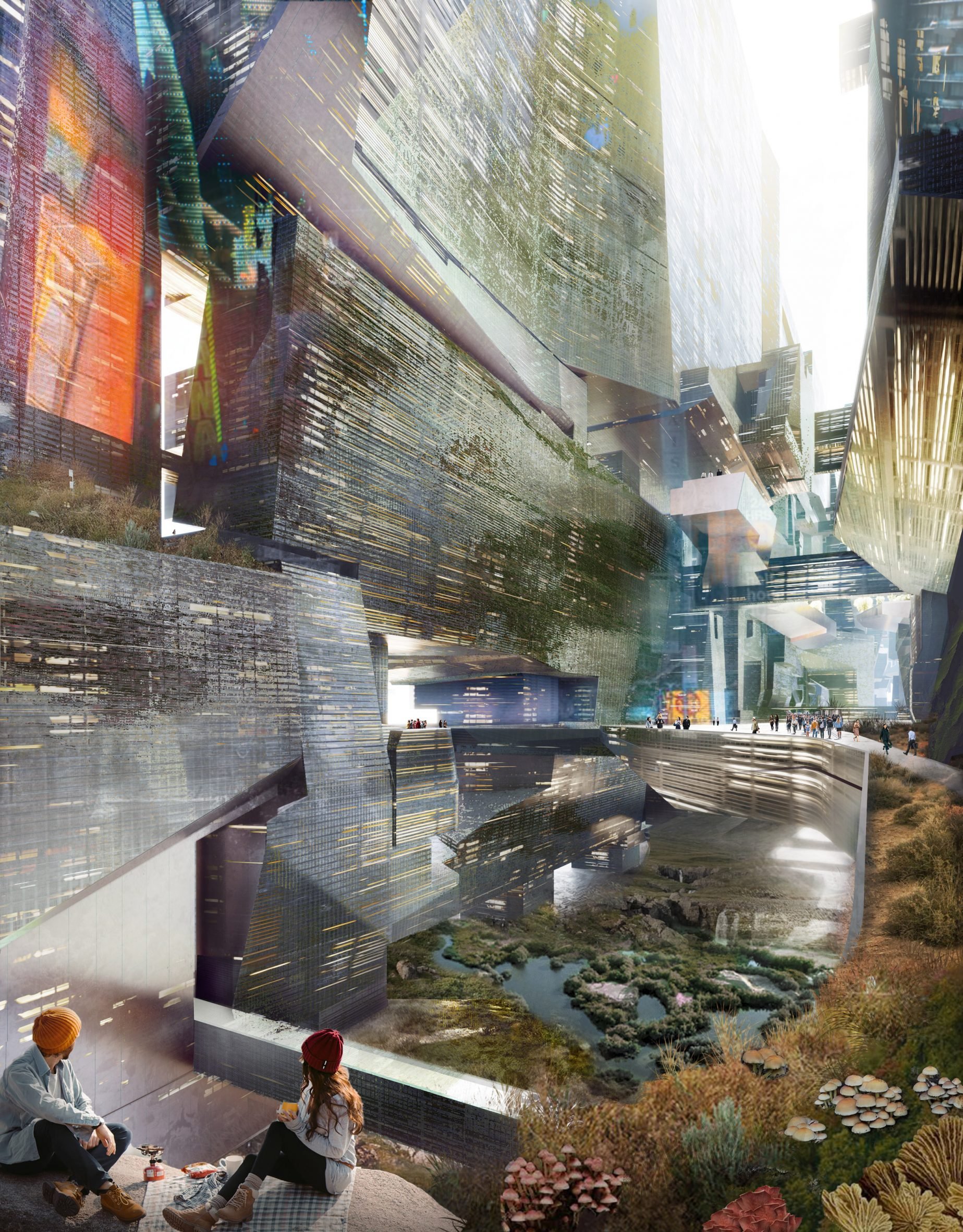

The structure will consist of two wall-like structures that will enclose an open area between them. At 500 metres high the pair of structures will become the 12th highest building in the world, as well as being by far the longest. The structure, which was designed to house nine million residents when it is complete, will contain residential, retail and leisure areas as well as schools and parks. The different functions will be stacked in an arrangement described by the city's creators as Zero Gravity Urbanism.

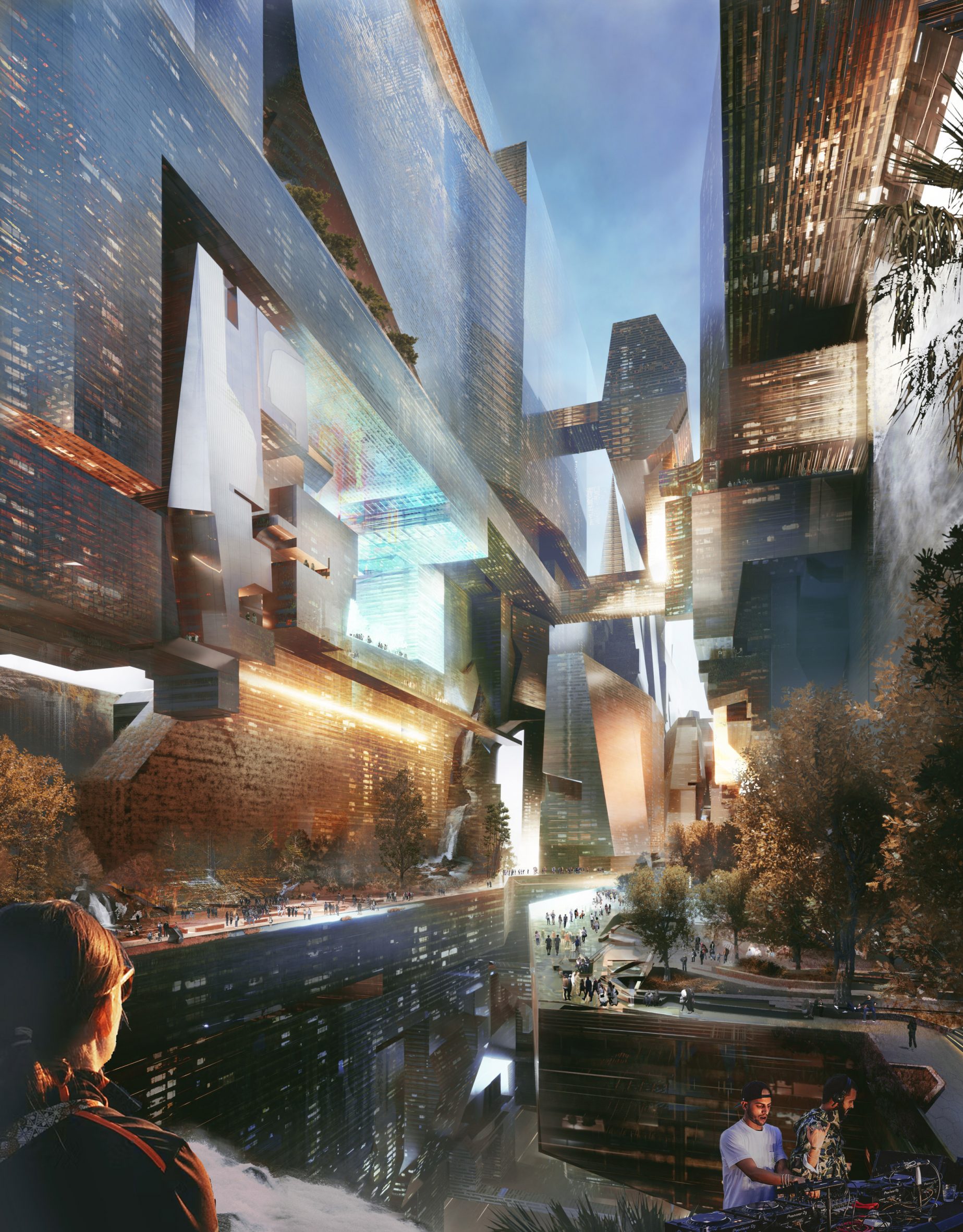
Visuals show parks placed between the two linear blocks, which will be connected by multiple bridges and topped with more green spaces. It will be entirely clad in mirrored facades to give the structure a unique appearance. "The Line will have an outer mirror facade that will provide its unique character and allow even its small footprint to blend with nature, while the interior will be built to create extraordinary experiences and magical moments," said the Saudi Arabian government. A transport system running the length of the megastructure would be designed to connect both ends of the city within 20 minutes. According to the Saudi Arabian government, the structure will be entirely powered by renewable energy and was designed as a sustainable alternative to traditional cities.
snip


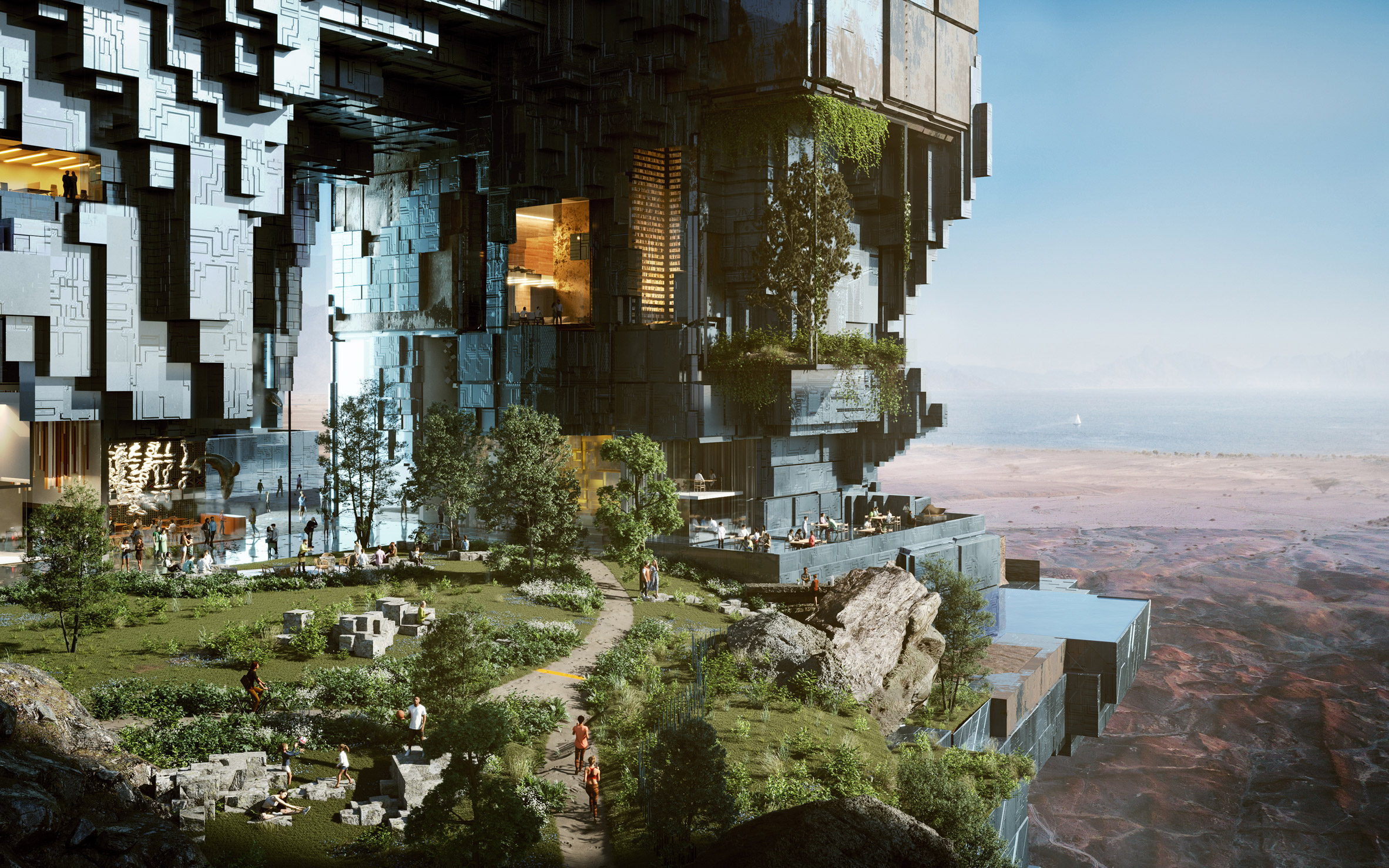
Saudi Arabia reveals 170-kilometre-long mirrored skyscraper to house nine million people
https://www.dezeen.com/2022/07/26/neon-170-kilometre-long-skyscraper-city-saudi-arabia/


The Saudi Arabian government has unveiled visuals of a 500-metre-tall linear city named The Line, which will be built near the Red Sea as part of Neom. Set to stretch 170 kilometres across northwest Saudi Arabia, the megastructure, which will have mirrored facades, will be 500 metres tall, but only 200 meters wide. Planned as part of the Neom development, The Line was designed as a dramatic alternative to traditional cities that typically radiate out from a central point. Although it has not been officially announced, Dezeen understands that the megastructure was designed by US studio Morphosis.



"At The Line’s launch last year, we committed to a civilizational revolution that puts humans first based on a radical change in urban planning," said Saudi Arabia's crown prince Mohammed bin Salman. "The designs revealed today for the city's vertically layered communities will challenge the traditional flat, horizontal cities and create a model for nature preservation and enhanced human liveability," he continued. "The Line will tackle the challenges facing humanity in urban life today and will shine a light on alternative ways to live."



The structure will consist of two wall-like structures that will enclose an open area between them. At 500 metres high the pair of structures will become the 12th highest building in the world, as well as being by far the longest. The structure, which was designed to house nine million residents when it is complete, will contain residential, retail and leisure areas as well as schools and parks. The different functions will be stacked in an arrangement described by the city's creators as Zero Gravity Urbanism.


Visuals show parks placed between the two linear blocks, which will be connected by multiple bridges and topped with more green spaces. It will be entirely clad in mirrored facades to give the structure a unique appearance. "The Line will have an outer mirror facade that will provide its unique character and allow even its small footprint to blend with nature, while the interior will be built to create extraordinary experiences and magical moments," said the Saudi Arabian government. A transport system running the length of the megastructure would be designed to connect both ends of the city within 20 minutes. According to the Saudi Arabian government, the structure will be entirely powered by renewable energy and was designed as a sustainable alternative to traditional cities.
snip



July 28, 2022
That will really drive his voter turnout for the midterms!!

https://threadreaderapp.com/thread/1552294858840330246.html

https://twitter.com/veenadubal/status/1552313652702748675


STATEMENT IN RESPONSE TO THE INTRODUCTION OF THE WORKER FLEXIBILITY AND CHOICE ACT
https://www.nelp.org/news-releases/statement-in-response-to-the-introduction-of-the-worker-flexibility-and-choice-act/
Following is a statement from Rebecca Dixon, executive director of the National Employment Law Project, on the introduction of the Worker Flexibility and Choice Act (H.R. 8442):
snip
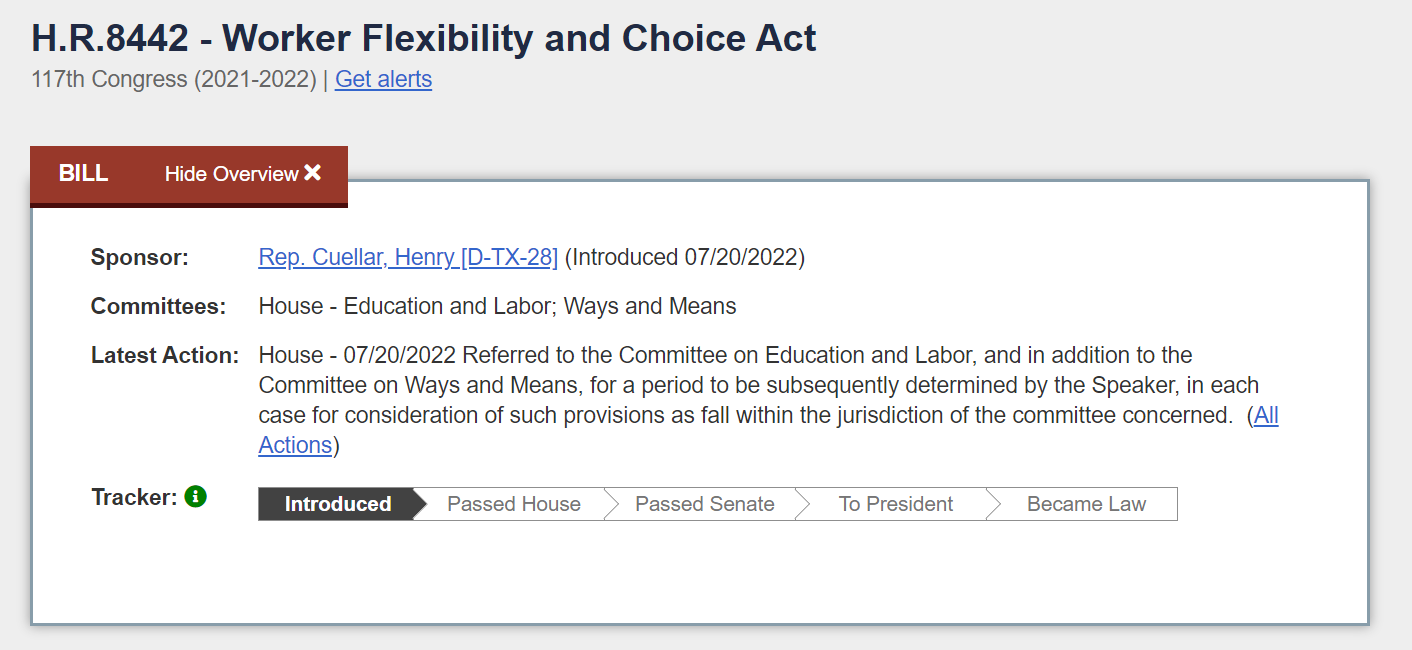
Henry Cuellar partners w/ ultra MAGAt Elise Stefanik on Bill to strip away minimum wage & OT
from many workers.That will really drive his voter turnout for the midterms!!
https://threadreaderapp.com/thread/1552294858840330246.html

TERRIFYING: The text of @RepCuellar's bill the Workplace Flexibility & Choice Act is available.
It would carve workers out of min wage & OT protections -- not just app-deployed workers -- ANY WORKER whose employer...1/
https://www.congress.gov/bill/117th-congress/house-bill/8442/text
Decided that they would set schedules using algorithms & incentives instead of providing secure hours WOULD NO LONGER HAVE TO PROVIDE A WAGE FLOOR or OVERTIME. 2/
Employers have been trying to get of the minimum wage for a century so they can squeeze more labor out of each human. For workers w/o bargaining power (non-union workers, workers of color, low-wage workers) this bill would make earning a living nearly impossible. 3/
As Uber, DoorDash, and Instacart have already done to their workforce, it would empower employers to force workers to work long and hard to eek out a living. The everyday gamble, insecurity, & stress of gig work would extend beyond these sectors... 4/
And all in the false name of flexibility. We know Uber driving is not flexible like they pretend it is -- there is nothing flexible about making so little that you have to eat, sleep, and work in your car to provide for your family. 5/
This bill is unconscionable. It is an outrage. It would increase economic inequality--especially racialized inequality. We must rise up against this tech-capital driven DYSTOPIA. Workers should have secure, living wages AND real time flexibility. Let's legislate for THAT. 6/END.
It would carve workers out of min wage & OT protections -- not just app-deployed workers -- ANY WORKER whose employer...1/
https://www.congress.gov/bill/117th-congress/house-bill/8442/text
Decided that they would set schedules using algorithms & incentives instead of providing secure hours WOULD NO LONGER HAVE TO PROVIDE A WAGE FLOOR or OVERTIME. 2/
Employers have been trying to get of the minimum wage for a century so they can squeeze more labor out of each human. For workers w/o bargaining power (non-union workers, workers of color, low-wage workers) this bill would make earning a living nearly impossible. 3/
As Uber, DoorDash, and Instacart have already done to their workforce, it would empower employers to force workers to work long and hard to eek out a living. The everyday gamble, insecurity, & stress of gig work would extend beyond these sectors... 4/
And all in the false name of flexibility. We know Uber driving is not flexible like they pretend it is -- there is nothing flexible about making so little that you have to eat, sleep, and work in your car to provide for your family. 5/
This bill is unconscionable. It is an outrage. It would increase economic inequality--especially racialized inequality. We must rise up against this tech-capital driven DYSTOPIA. Workers should have secure, living wages AND real time flexibility. Let's legislate for THAT. 6/END.
https://twitter.com/veenadubal/status/1552313652702748675


STATEMENT IN RESPONSE TO THE INTRODUCTION OF THE WORKER FLEXIBILITY AND CHOICE ACT
https://www.nelp.org/news-releases/statement-in-response-to-the-introduction-of-the-worker-flexibility-and-choice-act/
Following is a statement from Rebecca Dixon, executive director of the National Employment Law Project, on the introduction of the Worker Flexibility and Choice Act (H.R. 8442):
Earlier this week, backed by the corporate lobby group the Coalition for Workforce Innovation (CWI), which was established to fight against growing workers’ movements, Congresswoman Elise Stefanik (R-NY), Congresswoman Michelle Steel (R-CA), and Congressman Henry Cuellar (D-TX) introduced the deceptively named Worker Flexibility and Choice Act (WFCA).
This bill would radically erode fundamental worker protections in the United States to the benefit of big corporations, allowing them to require workers to sign away basic rights as a condition of work. The bill would also establish a second-tier employment class of disproportionately Black and immigrant workers working in arduous and underpaid jobs without minimum labor protections — growing poverty and racialized economic inequality.
The bill seeks to codify the false choice between scheduling flexibility and foundational rights. Because the Fair Labor Standards Act (FLSA) is already compatible with worker flexibility, it would be a fatal mistake for Congress to create a carveout for companies that demand “worker flexibility agreements” of their workforce. Corporations already have the ability to deliver flexibility to workers. Instead, they are using this bill to dramatically degrade the quality of work – including the basic requirement that they pay minimum wage and overtime for countless workers across the country.
The National Employment Law Project (NELP) believes that the movement for workers’ rights can defeat the Coalition for Workforce Innovation with worker organizing and policy innovation that expands labor protections and fixes the flaws in the New Deal and FLSA which left Black and immigrant workers segregated and unprotected.
This bill would radically erode fundamental worker protections in the United States to the benefit of big corporations, allowing them to require workers to sign away basic rights as a condition of work. The bill would also establish a second-tier employment class of disproportionately Black and immigrant workers working in arduous and underpaid jobs without minimum labor protections — growing poverty and racialized economic inequality.
The bill seeks to codify the false choice between scheduling flexibility and foundational rights. Because the Fair Labor Standards Act (FLSA) is already compatible with worker flexibility, it would be a fatal mistake for Congress to create a carveout for companies that demand “worker flexibility agreements” of their workforce. Corporations already have the ability to deliver flexibility to workers. Instead, they are using this bill to dramatically degrade the quality of work – including the basic requirement that they pay minimum wage and overtime for countless workers across the country.
The National Employment Law Project (NELP) believes that the movement for workers’ rights can defeat the Coalition for Workforce Innovation with worker organizing and policy innovation that expands labor protections and fixes the flaws in the New Deal and FLSA which left Black and immigrant workers segregated and unprotected.
snip

July 28, 2022
https://sneakernews.com/2022/06/30/barriers-converse-chuck-70-pro-leather-a01786c-a01787c/
Founded in 2015 and based in New York City, Barriers Worldwide is the vision of Steven Barter, a Valley Stream, New York-native who aims to educate through streetwear. Recently, the former-Visual Merchandiser at Nike unveiled his brand’s first-ever collaboration with Converse.
Drawing inspiration from The North Star, a 19th century publication focused on anti-slavery sentiment, Barter has reimagined the Chuck 70, Pro Leather and court-ready apparel in a way that makes Black history palpable to youth culture. The made-for-basketball designs have been reworked through the lens of lifestyle and culture, with a star motif linking the Boston-based institution to the centuries-old and long-defunct newspaper Barriers Worldwide has referenced.
The revolutionary canvas-covered high-top of the capsule is given a premium makeover, with “Black” material setting the stage for a series of embroidered text, co-branding and other details like heritage-inspired laces. “Egret”-colored sole units and toe caps indulge in an “aged” aesthetic that draw comparisons to old physical newspaper copies. By contrast, the Pro Leather is covered in brown suede fabric, with “BARRIERS” branding landing at thew lateral profile and top of the tongue. Sherpa-covered star-chevron logos also appear at the sides, while cowry shell-like lace dubraes offer protection to the wearer.






Barriers Worldwide Draws Inspiration From The North Star, A 19th Century Anti-Slavery Newspaper, For
Converse Collaborationhttps://sneakernews.com/2022/06/30/barriers-converse-chuck-70-pro-leather-a01786c-a01787c/
Founded in 2015 and based in New York City, Barriers Worldwide is the vision of Steven Barter, a Valley Stream, New York-native who aims to educate through streetwear. Recently, the former-Visual Merchandiser at Nike unveiled his brand’s first-ever collaboration with Converse.
Drawing inspiration from The North Star, a 19th century publication focused on anti-slavery sentiment, Barter has reimagined the Chuck 70, Pro Leather and court-ready apparel in a way that makes Black history palpable to youth culture. The made-for-basketball designs have been reworked through the lens of lifestyle and culture, with a star motif linking the Boston-based institution to the centuries-old and long-defunct newspaper Barriers Worldwide has referenced.
The revolutionary canvas-covered high-top of the capsule is given a premium makeover, with “Black” material setting the stage for a series of embroidered text, co-branding and other details like heritage-inspired laces. “Egret”-colored sole units and toe caps indulge in an “aged” aesthetic that draw comparisons to old physical newspaper copies. By contrast, the Pro Leather is covered in brown suede fabric, with “BARRIERS” branding landing at thew lateral profile and top of the tongue. Sherpa-covered star-chevron logos also appear at the sides, while cowry shell-like lace dubraes offer protection to the wearer.






July 28, 2022
https://www.thrillist.com/eat/nation/how-to-make-indian-pickles-at-home

Achaars, aka Indian pickles, are popular condiments in India. Achaar making is a popular activity during the hot summers, utilizing the bounty of peak produce. During my childhood, I would help my mother with the annual preparation, sneaking pieces of raw mango from the pile (I was too impatient to wait for the finished product). As an adult now living in the United States, I avoided making them and instead picked some up during trips home to India to visit family. My mom, mother-in-law, aunt, or friends were always happy to send us off with a bottle or two from their annual batch. But in the past few years, I’ve experimented with making small quantities of achaar here and there. While testing recipes for quick pickles to include in my cookbook Roti, I found it a calming and somewhat forgiving process.
Although it is not advisable to eat a jar-full of Indian achaar all at once, getting to know well-made achaars could very well make you a connoisseur. They aren’t difficult to make but like any good thing, require some time commitment. Once you learn how to make them, you will have a reliable stash of summer flavors to pull from at your leisure. The word “achar” or “achaar” is erroneously defined in the Collins Dictionary as a pickle made with mangoes. This is an incomplete description—which may explain why most people tend to get the concepts around Indian pickles wrong, too. Let us fix that by starting at the beginning.
Pickles represent preserved forms of a variety of fruits and vegetables that experience some degree of fermentation. They include a level of tanginess and can have a variety of whole spices. Most American, European, and Middle Eastern pickles are vegetables preserved in a liquid of brine and white or red vinegar, with a sprinkling of spices like dill, garlic, and pepper. Of the Asian pickles, East Asian pickles use a variety of pickling liquids varying from miso, sake, salt, soy sauce, ordinary vinegar, rice vinegar, and others. Marinated olives from many Mediterranean countries are perhaps the closest representative cousin to the Indian achaar.
South Asian achaars are common in countries like India, Bangladesh, Bhutan, Burma, Sri Lanka, Pakistan, and Nepal—since the spice palate includes familiar flavors. Indian achaars’ are predominantly oil-based preserves. There are hundreds of kinds of Indian achaars, and even then, every family personalizes the recipe to suit their preferences. The easiest way to understand how to make it is to know that every achaar requires three important ingredients and four critical steps. I’ve learned that apart from a few basic ground rules—like making sure everything is sanitized and dry before filling and storing—Indian achaars are far more adaptable than I previously believed.
What You Will Need To Get Started
snip





Preserve Peak Produce with This Indian Pickle Recipe
Making your own aachar will give you a reliable stash of summer flavors to pull from at your leisure.https://www.thrillist.com/eat/nation/how-to-make-indian-pickles-at-home

Achaars, aka Indian pickles, are popular condiments in India. Achaar making is a popular activity during the hot summers, utilizing the bounty of peak produce. During my childhood, I would help my mother with the annual preparation, sneaking pieces of raw mango from the pile (I was too impatient to wait for the finished product). As an adult now living in the United States, I avoided making them and instead picked some up during trips home to India to visit family. My mom, mother-in-law, aunt, or friends were always happy to send us off with a bottle or two from their annual batch. But in the past few years, I’ve experimented with making small quantities of achaar here and there. While testing recipes for quick pickles to include in my cookbook Roti, I found it a calming and somewhat forgiving process.
Although it is not advisable to eat a jar-full of Indian achaar all at once, getting to know well-made achaars could very well make you a connoisseur. They aren’t difficult to make but like any good thing, require some time commitment. Once you learn how to make them, you will have a reliable stash of summer flavors to pull from at your leisure. The word “achar” or “achaar” is erroneously defined in the Collins Dictionary as a pickle made with mangoes. This is an incomplete description—which may explain why most people tend to get the concepts around Indian pickles wrong, too. Let us fix that by starting at the beginning.
Pickles represent preserved forms of a variety of fruits and vegetables that experience some degree of fermentation. They include a level of tanginess and can have a variety of whole spices. Most American, European, and Middle Eastern pickles are vegetables preserved in a liquid of brine and white or red vinegar, with a sprinkling of spices like dill, garlic, and pepper. Of the Asian pickles, East Asian pickles use a variety of pickling liquids varying from miso, sake, salt, soy sauce, ordinary vinegar, rice vinegar, and others. Marinated olives from many Mediterranean countries are perhaps the closest representative cousin to the Indian achaar.
South Asian achaars are common in countries like India, Bangladesh, Bhutan, Burma, Sri Lanka, Pakistan, and Nepal—since the spice palate includes familiar flavors. Indian achaars’ are predominantly oil-based preserves. There are hundreds of kinds of Indian achaars, and even then, every family personalizes the recipe to suit their preferences. The easiest way to understand how to make it is to know that every achaar requires three important ingredients and four critical steps. I’ve learned that apart from a few basic ground rules—like making sure everything is sanitized and dry before filling and storing—Indian achaars are far more adaptable than I previously believed.
What You Will Need To Get Started
snip





July 28, 2022
https://archive.ph/x8Fv9

YIELD 4 servings
TIME 40 minutes
This mouthwatering salad of ripe, juicy tomatoes is dressed with a quick, vinegary dressing and finished with cheesy, garlicky bread crumbs, which bring pizza flavors to this summery dish. The tomatoes are salted for seasoning, but also to make their sweet juices pool out, creating a saucy base. Made with a combination of Parmesan, olives, garlic, spices and citrus zest, the bread crumbs can be prepared one week in advance. (Store in an airtight container and “refresh” them by warming them in the oven or on a stove-top until crisp and fragrant. Make extra to go on caramelized zucchini pasta or even lemony shrimp and white bean stew) Serve the tomatoes as a grand appetizer, or as a light supper with grilled chicken or steak.
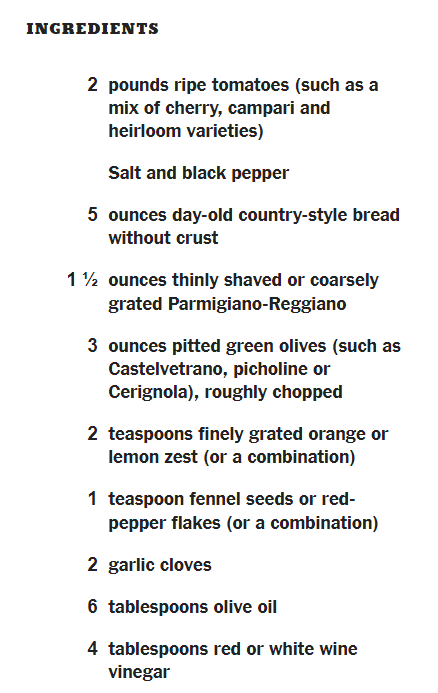
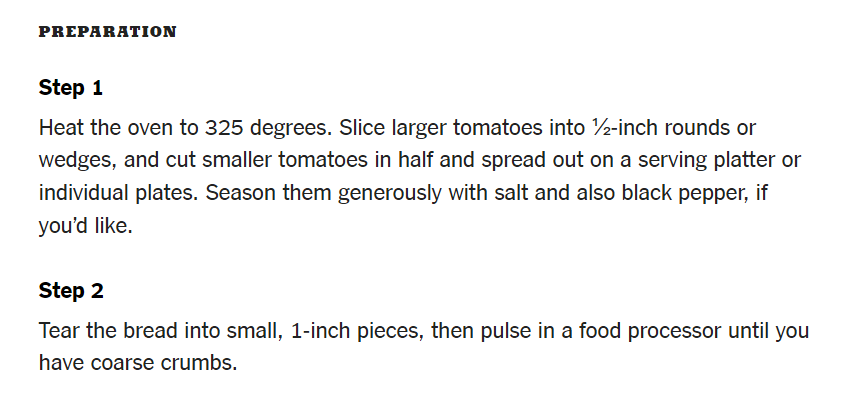
snip
Juicy Tomatoes With Parmesan-Olive Bread Crumbs
https://cooking.nytimes.com/recipes/1023349-juicy-tomatoes-with-parmesan-olive-bread-crumbshttps://archive.ph/x8Fv9

YIELD 4 servings
TIME 40 minutes
This mouthwatering salad of ripe, juicy tomatoes is dressed with a quick, vinegary dressing and finished with cheesy, garlicky bread crumbs, which bring pizza flavors to this summery dish. The tomatoes are salted for seasoning, but also to make their sweet juices pool out, creating a saucy base. Made with a combination of Parmesan, olives, garlic, spices and citrus zest, the bread crumbs can be prepared one week in advance. (Store in an airtight container and “refresh” them by warming them in the oven or on a stove-top until crisp and fragrant. Make extra to go on caramelized zucchini pasta or even lemony shrimp and white bean stew) Serve the tomatoes as a grand appetizer, or as a light supper with grilled chicken or steak.


snip
July 28, 2022
https://www.nytimes.com/2022/07/26/business/imf-world-economy.html
https://archive.ph/Q02oL

The world could soon be on the brink of a global recession as the economies of the United States, China and Europe slow more sharply than anticipated amid a collision of crises, the International Monetary Fund warned on Tuesday. In an update of the World Economic Outlook, the I.M.F. said economic prospects had darkened significantly in recent months as war in Ukraine, inflation and a resurgent pandemic inflicted pain on every continent. If the thicket of threats continues to intensify, the world economy faces one of its weakest years since 1970, a period of intense stagflation across the globe.
“The world may soon be teetering on the edge of a global recession, only two years after the last one,” Pierre-Olivier Gourinchas, the I.M.F.’s chief economist, wrote in a blog post accompanying the report. Put simply, the outlook for the global economy is “increasingly gloomy,” he wrote. The I.M.F. downgraded its global growth forecasts from its April projections, predicting that output will fall to 3.2 percent in 2022, from 6.1 percent last year. Growth is expected to slow even further next year as central banks around the world raise interest rates in an effort to tame inflation by cooling their economies.
Inflation is also rising more rapidly and broadly than the I.M.F. anticipated earlier this year. It now expects prices to rise 6.6 percent in rich countries and 9.5 percent in emerging markets and developing economies. The international group also warned of another problem that could emerge as the Fed raises interest rates. Higher rates are expected to further strengthen the U.S. dollar as investors plow into Treasury bonds that offer lucrative returns. The I.M.F. said inflation in emerging markets could be amplified as the appreciation of the dollar made the imports that they bought with their local currencies more expensive.
Poor countries are already struggling to cope with a food crisis, as exports of grains and cooking oils from Russia and Ukraine have been disrupted by the war, fueling a surge in food costs and raising fears about the prospects of famine and social unrest. “The risks to the outlook are overwhelmingly tilted to the downside,” the I.M.F. said. The economic storm facing the world is the result of diminished consumer spending power in the United States, the impact of Russia’s invasion of Ukraine on Europe’s economies, and the property crisis and lockdowns in China, where Beijing continues to take severe measures to contain coronavirus outbreaks.
snip
The I.M.F. warns that a global recession could soon be at hand.
The International Monetary Fund downgraded its growth forecasts and projected higher inflation around the world.https://www.nytimes.com/2022/07/26/business/imf-world-economy.html
https://archive.ph/Q02oL

The world could soon be on the brink of a global recession as the economies of the United States, China and Europe slow more sharply than anticipated amid a collision of crises, the International Monetary Fund warned on Tuesday. In an update of the World Economic Outlook, the I.M.F. said economic prospects had darkened significantly in recent months as war in Ukraine, inflation and a resurgent pandemic inflicted pain on every continent. If the thicket of threats continues to intensify, the world economy faces one of its weakest years since 1970, a period of intense stagflation across the globe.
“The world may soon be teetering on the edge of a global recession, only two years after the last one,” Pierre-Olivier Gourinchas, the I.M.F.’s chief economist, wrote in a blog post accompanying the report. Put simply, the outlook for the global economy is “increasingly gloomy,” he wrote. The I.M.F. downgraded its global growth forecasts from its April projections, predicting that output will fall to 3.2 percent in 2022, from 6.1 percent last year. Growth is expected to slow even further next year as central banks around the world raise interest rates in an effort to tame inflation by cooling their economies.
Inflation is also rising more rapidly and broadly than the I.M.F. anticipated earlier this year. It now expects prices to rise 6.6 percent in rich countries and 9.5 percent in emerging markets and developing economies. The international group also warned of another problem that could emerge as the Fed raises interest rates. Higher rates are expected to further strengthen the U.S. dollar as investors plow into Treasury bonds that offer lucrative returns. The I.M.F. said inflation in emerging markets could be amplified as the appreciation of the dollar made the imports that they bought with their local currencies more expensive.
Poor countries are already struggling to cope with a food crisis, as exports of grains and cooking oils from Russia and Ukraine have been disrupted by the war, fueling a surge in food costs and raising fears about the prospects of famine and social unrest. “The risks to the outlook are overwhelmingly tilted to the downside,” the I.M.F. said. The economic storm facing the world is the result of diminished consumer spending power in the United States, the impact of Russia’s invasion of Ukraine on Europe’s economies, and the property crisis and lockdowns in China, where Beijing continues to take severe measures to contain coronavirus outbreaks.
snip
July 28, 2022
One hurdle down (Manchin) on the BBB, 3 to go: the Senate parliamentarian, Sinema, and Gottheimer's
Problem Solver/Blue Dog crew (who are going to go ballistic as their SALT cap raise is NOT in the deal).
Sinema has said over and over no go for pharma price reform, although the deal does NOT have the tax hikes on the rich and corporations she said NO to.
I also do not trust the parliamentarian tbh. It is madness for one, unelected person to have THAT much power.
https://edition.cnn.com/2022/07/27/politics/schumer-manchin-deal-build-back-better/index.html
snip
Medicare drug price negotiation provisions remain in the bill
The deal keeps the prescription drug prices changes that Manchin had previously agreed to, including empowering Medicare to negotiate the price of certain costly medications administered in doctors' offices or purchased at the pharmacy. The Health and Human Services secretary would negotiate the prices of 10 drugs in 2026, and another 15 drugs in 2027 and again in 2028. The number would rise to 20 drugs a year for 2029 and beyond. It would also redesign Medicare's Part D drug plans so that seniors and people with disabilities wouldn't pay more than $2,000 a year for medication bought at the pharmacy. And, the deal would require drug companies to pay rebates if they increase their prices in the Medicare and private-insurance markets faster than inflation. Altogether, the drug price provisions would reduce the deficit by $288 billion over a decade, according to the Congressional Budget Office.
The deal keeps the prescription drug prices changes that Manchin had previously agreed to, including empowering Medicare to negotiate the price of certain costly medications administered in doctors' offices or purchased at the pharmacy. The Health and Human Services secretary would negotiate the prices of 10 drugs in 2026, and another 15 drugs in 2027 and again in 2028. The number would rise to 20 drugs a year for 2029 and beyond. It would also redesign Medicare's Part D drug plans so that seniors and people with disabilities wouldn't pay more than $2,000 a year for medication bought at the pharmacy. And, the deal would require drug companies to pay rebates if they increase their prices in the Medicare and private-insurance markets faster than inflation. Altogether, the drug price provisions would reduce the deficit by $288 billion over a decade, according to the Congressional Budget Office.
Paying for the bill
To raise revenue, the bill would impose a 15% minimum tax on corporations, which would raise $313 billion over a decade. While details on the current deal remain scant, the House version of the Build Back Better package would have levied the tax on the corporate profits that large companies report to shareholders, not to the Internal Revenue Service. It would have applied to companies with more than $1 billion in profits and yielded a similar revenue-raising figure. The current deal also aims to close the carried interest loophole, which allows investment managers to treat their compensation as capital gains and pay a 20% long-term capital gains tax rate instead of income tax rates of up to 37%. Eliminating this loophole, which would raise $14 billion over a decade, has been a longtime goal of congressional Democrats.
The package also calls for providing more funding to the IRS for tax enforcement, which would raise $124 billion.
Democrats say families making less than $400,000 per year would not be affected, in line with a pledge by Biden. Also, there would be no new taxes on small businesses. Manchin said in a statement that the deal would ensure "that large corporations and the ultra-wealthy pay their fair share in taxes," though it doesn't contain the tax rate hikes on rich Americans and big companies that Democrats initially wanted to include in the budget reconciliation packages before they were shot down by Democratic Sen. Kyrsten Sinema of Arizona.
To raise revenue, the bill would impose a 15% minimum tax on corporations, which would raise $313 billion over a decade. While details on the current deal remain scant, the House version of the Build Back Better package would have levied the tax on the corporate profits that large companies report to shareholders, not to the Internal Revenue Service. It would have applied to companies with more than $1 billion in profits and yielded a similar revenue-raising figure. The current deal also aims to close the carried interest loophole, which allows investment managers to treat their compensation as capital gains and pay a 20% long-term capital gains tax rate instead of income tax rates of up to 37%. Eliminating this loophole, which would raise $14 billion over a decade, has been a longtime goal of congressional Democrats.
The package also calls for providing more funding to the IRS for tax enforcement, which would raise $124 billion.
Democrats say families making less than $400,000 per year would not be affected, in line with a pledge by Biden. Also, there would be no new taxes on small businesses. Manchin said in a statement that the deal would ensure "that large corporations and the ultra-wealthy pay their fair share in taxes," though it doesn't contain the tax rate hikes on rich Americans and big companies that Democrats initially wanted to include in the budget reconciliation packages before they were shot down by Democratic Sen. Kyrsten Sinema of Arizona.
Notably, Manchin also threw cold water on one of Schumer's priorities -- addressing the $10,000 cap on state and local tax deductions, known as SALT, that was part of the GOP tax cut package in 2017 and affects many states in the Northeast and on the West Coast. Many details of the current deal remain to be worked out, which could delay or scuttle it, said Howard Gleckman, a senior fellow at the nonpartisan Tax Policy Center.
July 28, 2022
Two scholars are trying to calculate just how polarized the United States has been over the past four decades — and how split it is now.
https://www.nytimes.com/2022/07/27/us/politics/vanderbilt-unity-index.html
https://archive.ph/F3rPq

At a time of sporadic-but-disturbing episodes of political violence in America, of intense disputes over state and federal power and even of loose talk about the possibility of another civil war, is there any way to calculate how divided we are? Or do we just need to trust our gut? Two scholars at Vanderbilt University are trying for a more precise estimate. Their new measure, called the Vanderbilt Unity Index, uses a variety of indicators to quantify just how united or disunited the United States has been over the past four decades.
“No surprise — it’s gotten worse,” said John Geer, the dean of the university’s College of Arts and Science and co-director of its Vanderbilt Poll. The index ranges from zero to 100, with zero meaning no unity whatsoever, and 100 meaning complete unity. Most of the time, the country is somewhere between 50 and 70 or so.

Geer pointed to a 40-year graph his team put together, which showed the trend line peaking in the high 60s or low 70s in 1981, the first year measured, followed by a slow but obvious drop to its nadir during the Trump administration. The data shows plenty of peaks and valleys in between, however.
The lowest point in the index came after the “Unite the Right” rally of white supremacist groups in Charlottesville, Va., which led to a backlash against President Donald Trump after he infamously defended the participants as including “some very fine people.” High points included moments when Americans banded together amid geopolitical crises, including the Sept. 11, 2001, attacks and the first Gulf War in Iraq.
snip
On Politics: Calculating just how divided America is
Measuring America’s Divide: ‘It’s Gotten Worse’Two scholars are trying to calculate just how polarized the United States has been over the past four decades — and how split it is now.
https://www.nytimes.com/2022/07/27/us/politics/vanderbilt-unity-index.html
https://archive.ph/F3rPq

At a time of sporadic-but-disturbing episodes of political violence in America, of intense disputes over state and federal power and even of loose talk about the possibility of another civil war, is there any way to calculate how divided we are? Or do we just need to trust our gut? Two scholars at Vanderbilt University are trying for a more precise estimate. Their new measure, called the Vanderbilt Unity Index, uses a variety of indicators to quantify just how united or disunited the United States has been over the past four decades.
“No surprise — it’s gotten worse,” said John Geer, the dean of the university’s College of Arts and Science and co-director of its Vanderbilt Poll. The index ranges from zero to 100, with zero meaning no unity whatsoever, and 100 meaning complete unity. Most of the time, the country is somewhere between 50 and 70 or so.

Geer pointed to a 40-year graph his team put together, which showed the trend line peaking in the high 60s or low 70s in 1981, the first year measured, followed by a slow but obvious drop to its nadir during the Trump administration. The data shows plenty of peaks and valleys in between, however.
The lowest point in the index came after the “Unite the Right” rally of white supremacist groups in Charlottesville, Va., which led to a backlash against President Donald Trump after he infamously defended the participants as including “some very fine people.” High points included moments when Americans banded together amid geopolitical crises, including the Sept. 11, 2001, attacks and the first Gulf War in Iraq.
snip
July 26, 2022
https://www.dezeen.com/2022/07/21/australias-first-purpose-built-pride-centre-brearley-architects-urbanists-grant-amon-architects/
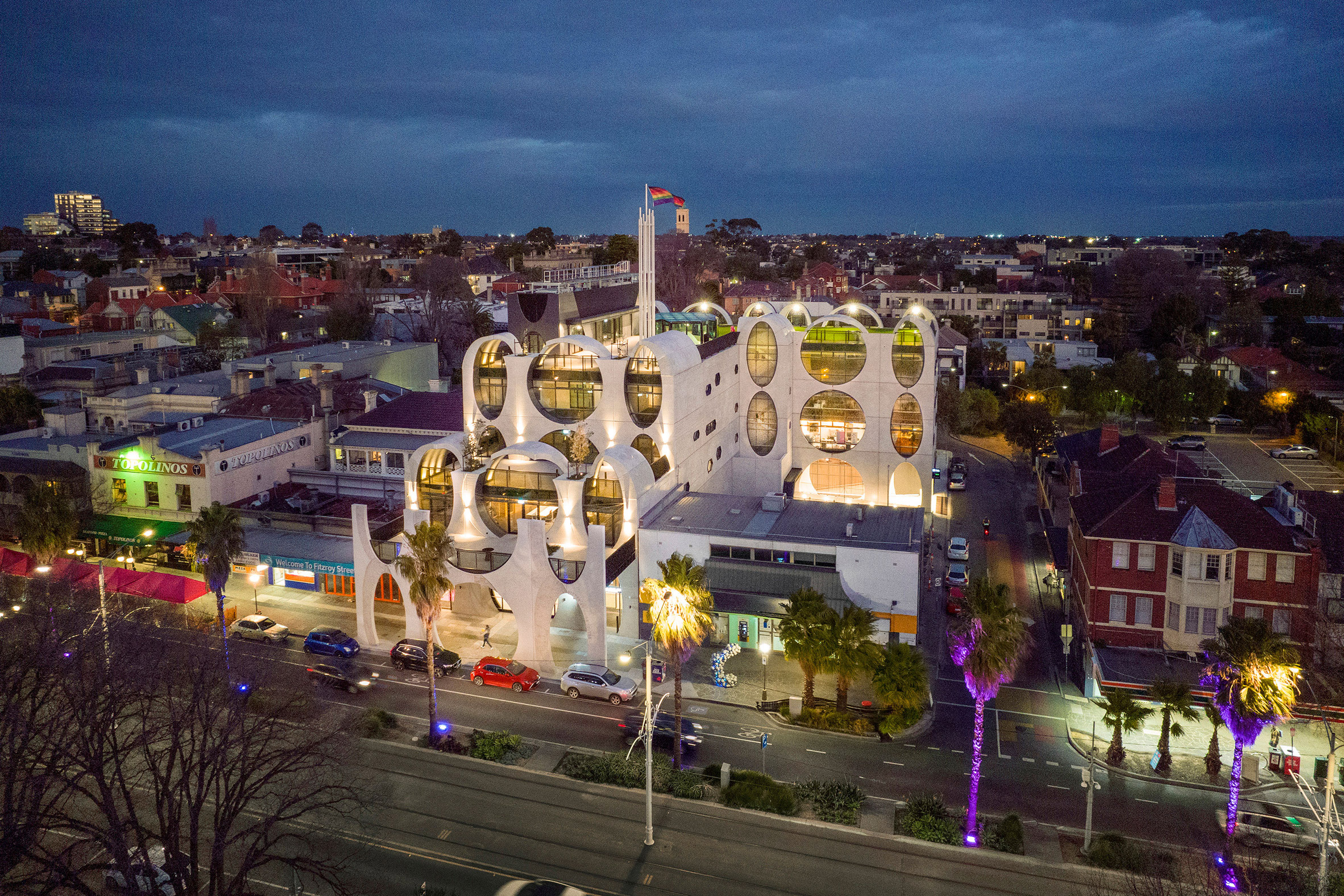
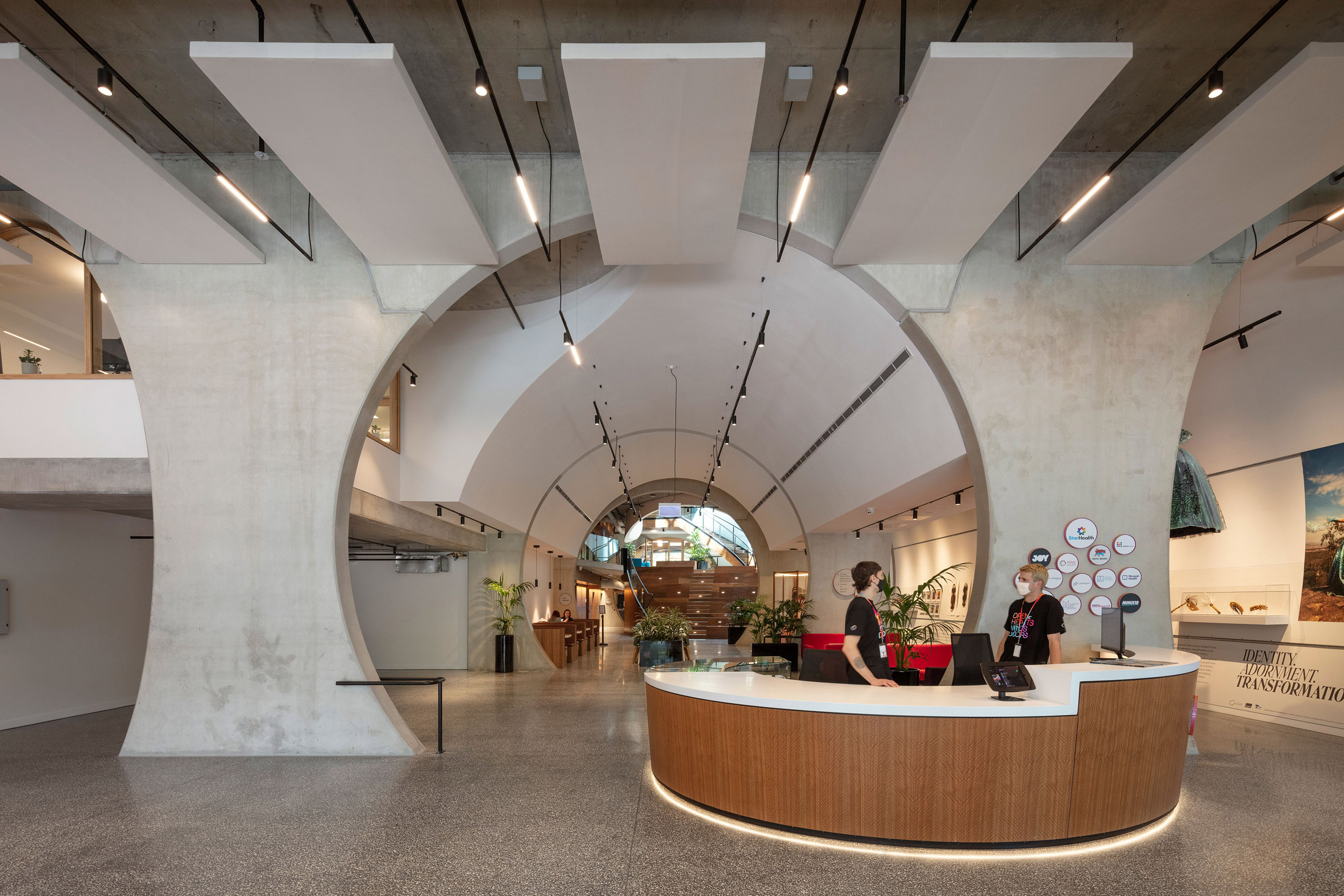


Australian architecture studios Brearley Architects and Urbanists and Grant Amon Architects have created Australia's first purpose-built centre for LGBTQ+ communities that incorporates tubular openings across its façade. The Victorian Pride Centre is a five-storey building located in Melbourne's beachside suburb of St Kilda and offers its queer community access to a number of services and safe spaces.
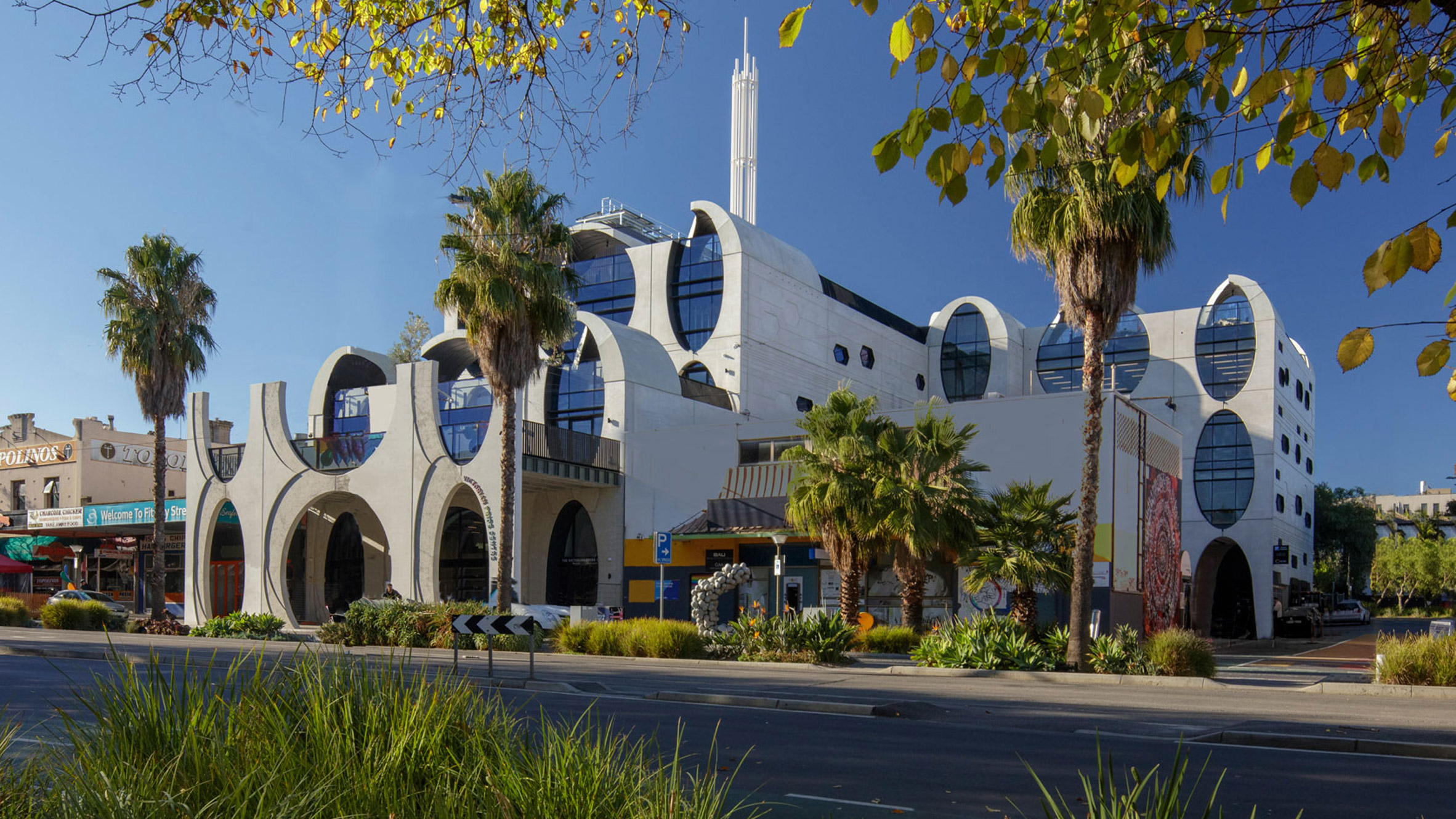

L-shaped in plan, the form of the building was derived from a collection of tubes organised in a stacked formation that grow taller as its volumes stagger further from the street. Its façade incorporates circular and oval-shaped cut-outs across its street elevation and is used as a shaded portico on its street-facing ground level as well as sculptural terraces across its first and second.


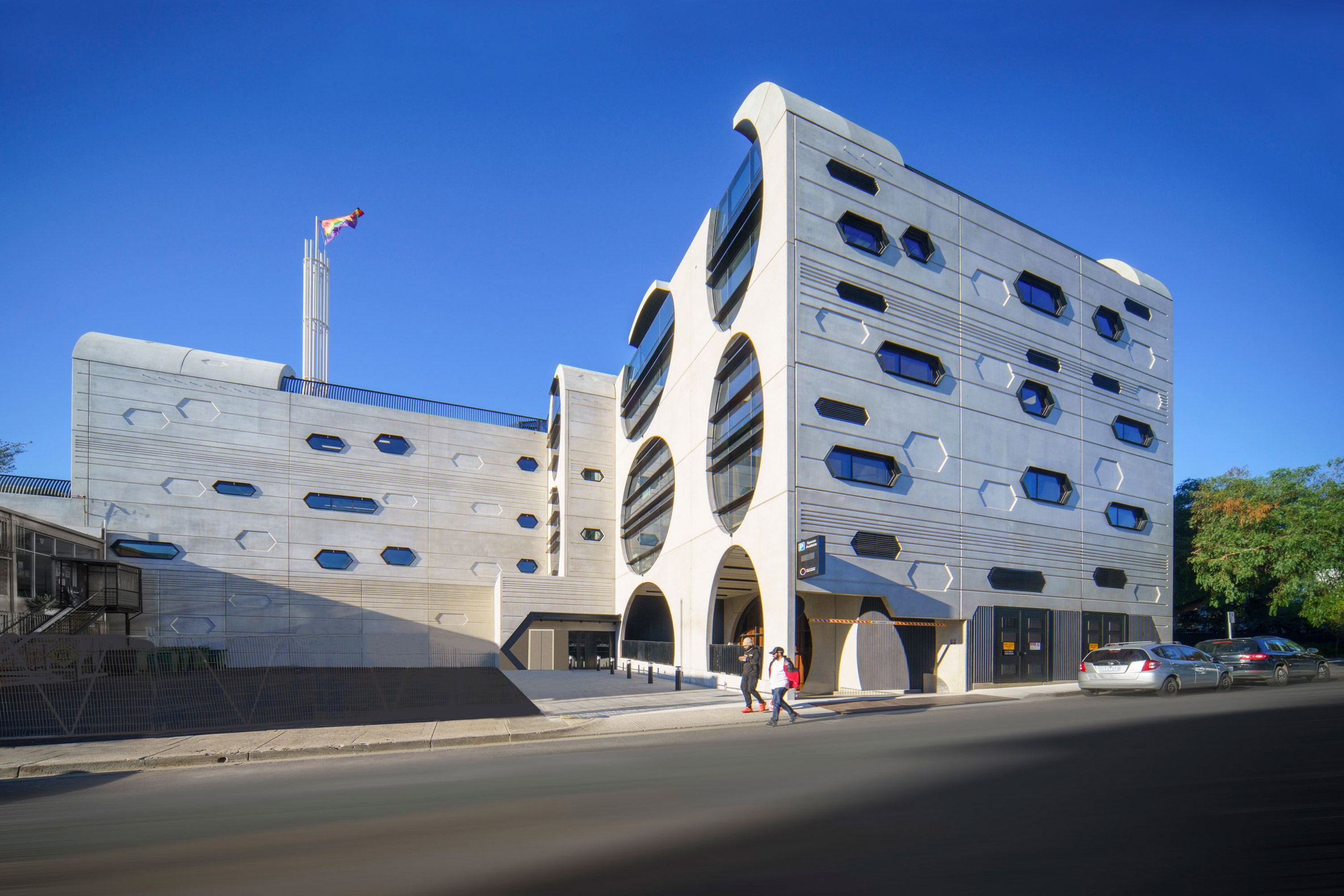
The concrete exterior is detailed with a skewed shadow of the circular cut-outs that punctuate its façade – exposing the textural layers of concrete beneath. Terraces are located at the front, street-facing areas of the building providing the Victorian Pride Centre with a prime location for events as well as viewing areas for relevant street parades and marches.




Designed by Brearley Architects and Urbanists and Grant Amon Architects, the building houses a number of organisations that will use the centre as their base while also providing spaces for external group meetings, events and projects. Alongside its workspaces, the Victorian Pride Centre contains health and welfare centres, a book shop, a gallery and a theatre. A café, rooftop events space and a community garden or set to be added as the next stage of development.
snip




Australia's first purpose-built Pride Centre unveiled in St Kilda, Melbourne
Brearley Architects and Urbanists and Grant Amon Architects unveil Australia's first purpose-built Pride Centrehttps://www.dezeen.com/2022/07/21/australias-first-purpose-built-pride-centre-brearley-architects-urbanists-grant-amon-architects/




Australian architecture studios Brearley Architects and Urbanists and Grant Amon Architects have created Australia's first purpose-built centre for LGBTQ+ communities that incorporates tubular openings across its façade. The Victorian Pride Centre is a five-storey building located in Melbourne's beachside suburb of St Kilda and offers its queer community access to a number of services and safe spaces.


L-shaped in plan, the form of the building was derived from a collection of tubes organised in a stacked formation that grow taller as its volumes stagger further from the street. Its façade incorporates circular and oval-shaped cut-outs across its street elevation and is used as a shaded portico on its street-facing ground level as well as sculptural terraces across its first and second.



The concrete exterior is detailed with a skewed shadow of the circular cut-outs that punctuate its façade – exposing the textural layers of concrete beneath. Terraces are located at the front, street-facing areas of the building providing the Victorian Pride Centre with a prime location for events as well as viewing areas for relevant street parades and marches.




Designed by Brearley Architects and Urbanists and Grant Amon Architects, the building houses a number of organisations that will use the centre as their base while also providing spaces for external group meetings, events and projects. Alongside its workspaces, the Victorian Pride Centre contains health and welfare centres, a book shop, a gallery and a theatre. A café, rooftop events space and a community garden or set to be added as the next stage of development.
snip




Profile Information
Gender: FemaleHometown: London
Home country: US/UK/Sweden
Current location: Stockholm, Sweden
Member since: Sun Jul 1, 2018, 07:25 PM
Number of posts: 43,584